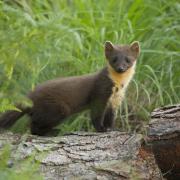The variety of beetles in the UK is staggering – around 4,000 different species. They do lots of important jobs, from shifting dung to pollinating plants. Some are fast and agile hunters, others trundle along at their own pace.
They can be black or brightly coloured, plain or patterned. Find a love for beetles and there will always be something new to discover.
Ladybirds are probably our most familiar beetles – and also some of the most popular. They’re known as the gardener’s friend, as many hunt the aphids that occasionally feed on our prized plants. The classic image of a ladybird is the 7-spot, with seven black spots dotted across its bright red back. But there are around 47 species of ladybird in the UK, with a variety of different colours and patterns.
THE LADYBIRD LIFECYCLE
As with butterflies, ladybirds have a four-stage lifecycle: egg, larva, pupa, adult.
The adults lay eggs, which hatch into young known as larvae. The larvae feed and grow in stages, casting off their exoskeleton to grow a larger one each time. These stages are known as ‘instars’ and there are four of them.
When the larvae are fully grown, they become pupae. They attach themselves to a leaf or other surface and turn into a hardened case – these often just look like a patterned blob. Within this case, they transform into adult beetles.
When the beetles first emerge from their pupae, they lack the familiar colours and patterns. It can take a few days for these colours to appear. These adult ladybirds will usually appear late in summer and spend the winter tucked away in crevices, ready to emerge again in spring.
ANATOMY OF A LADYBIRD
To identify ladybirds, it helps to know a little about their structure. Studying the patterns on the three main parts of their body can help reveal which species you’re looking at. The first part is the head, which is pretty obvious. The second part is the pronotum, which is the broad section directly behind the head. The third part is the wing cases (known as elytra), which cover the bulk of a ladybird’s back.
LOTS OF LADYBIRDS
Of the 47 or so ladybirds that live in the UK, only around 26 are considered ‘conspicuous ladybirds’. These are the large, colourful ladybirds that can often be spotted on plants. The other species are smaller, harder to find and harder to identify. Here are seven conspicuous ladybirds to look out for!

7-spot ladybird
The classic ladybird, found in parks and gardens across the UK. It’s a large ladybird, usually 5-8mm long. It has red wing cases, with three black spots on each side and a seventh spot in the middle, just behind the pronotum. Look for it on low-growing plants.

Harlequin ladybird
This Asian species first reached the UK in the early 2000s but is now common across England and Wales. It has also reached Scotland and Northern Ireland. It’s 5-8mm long, but comes in a confusing variety of colours and patterns. One helpful clue is that harlequins usually have reddish-brown legs.
One of the most commonly seen forms has orange/red wing cases with 15-21 black spots, and a whiteish pronotum with a black ‘M’-shaped marking. Another common form has black wing cases with four red spots. But more than 100 different colour patterns have been recorded!

Pine ladybird
This small ladybird is widespread in England and Wales, with scattered populations elsewhere in the UK. It grows to around 4mm and is all black, with four red markings on its wing cases. The front two markings are comma shaped. As the name suggests, it is often found on the trunks and branches of pine trees – but it can also be seen on other species.

Orange ladybird
This distinctive ladybird is found across the UK. It’s around 6mm long and orange all over, with 12-16 white spots on its wing cases. It feeds on mildew on leaves and is often seen around sycamore and ash trees.

14-spot ladybird
This attractive little ladybird is widespread in most of the UK, though scarcer in Scotland. It’s around 4mm long and usually yellow with black markings. The wings cases have rectangular black spots that often fuse together to form lines. It’s usually found close to the ground, amongst grasses and flowers.

22-spot ladybird
One of our brightest ladybirds, found throughout most of the UK but rare in Scotland. It’s a small species, around 3-4mm long. It has blazing yellow wing cases with 22 black spots. Like the orange ladybird, it feeds on mildew rather than aphids. It’s often found in meadows or on herbaceous plants in other areas. It’s apparently keen on hogweed.

Eyed ladybird
The UK’s largest ladybird, growing to around 8.5mm. It’s widespread in the UK, but not often seen. It spends much of its time in the canopy of conifer trees, particularly Scots pine, hunting aphids. Its wing cases are dark red, usually with 15 black spots – though spots can vary from zero to 23. The spots usually have pale rings around them.
Cotswold Great – Hummingbird hawk-moth

The hummingbird hawk-moth can be seen hovering, like a hummingbird, as it feeds on the nectar of flowers with its long proboscis. These unique moths migrate here from southern Europe each year from May onwards and can be seen until September.
If you spot one this summer, listen closely as you may hear a humming, caused by their fast-moving wings! These fluttering wings can also make hummingbird hawk-moths appear orange in flight, despite their grey bodies and black and white tails.
In some years, they can be common, and may be seen in gardens, grassland and scrub habitats. Look out for them at home on flowers like honeysuckle and buddleia, as well as at nature reserves like Crickley Hill, near Cheltenham.
![Garden Pond]() Garden Pond (Image: Megan Adamou)
Garden Pond (Image: Megan Adamou)
5 actions for wildlife this summer
1. Pledge a patch to the People’s Nature Reserve and set aside part of your garden for nature.
2. Build a wildlife pond, one of the single best features for attracting new wildlife to the garden.
3. Install a water butt, they're great for watering the garden, refilling the pond - or even washing the car!
4. Take part in a litter pick, any litter removed from a natural ecosystem helps wildlife and creates a better space for humans too!
5. Create a hedgehog hole to help hedgehogs get around, by making holes and access points in fences and barriers.
Find out more about taking action for nature at www.gloucestershirewildlifetrust.co.uk/TeamWilder

Did you know?
July is a great month to look for butterflies, but did you know that a large number of moths are also active in the day? With around 2,500 species of moth in the UK, there’s plenty to be keeping an eye out for. Some day-flying moths, like scarlet tiger moths, are just as brightly coloured as some of our butterflies and are often mistaken for them!




























